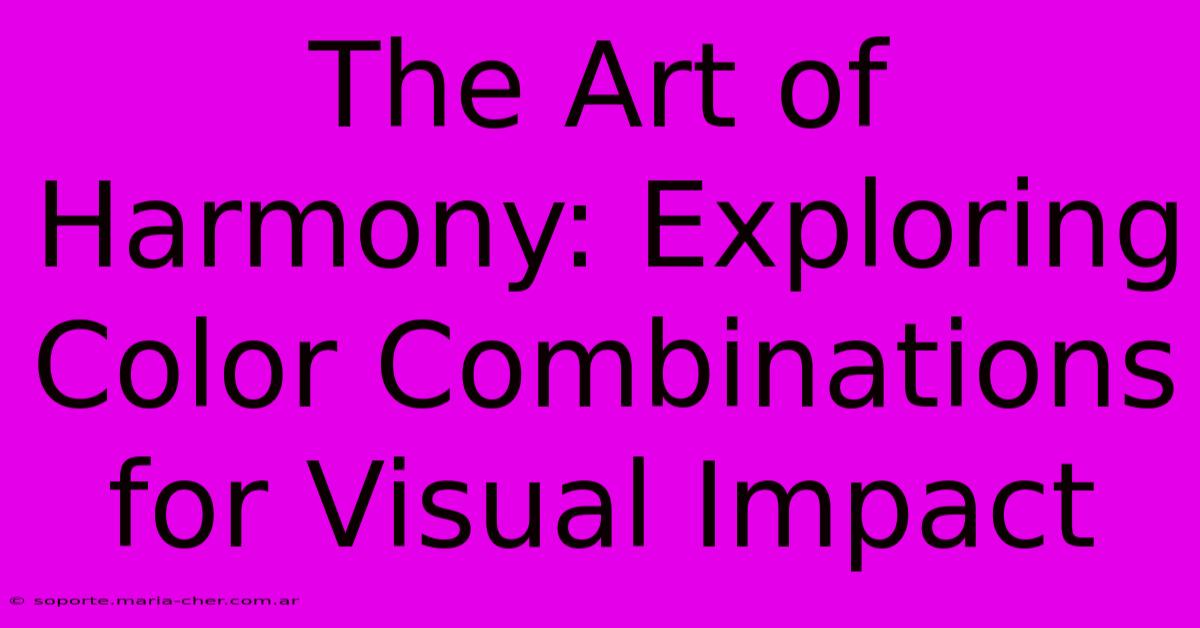The Art Of Harmony: Exploring Color Combinations For Visual Impact

Table of Contents
The Art of Harmony: Exploring Color Combinations for Visual Impact
Color is more than just a visual element; it's a powerful tool that evokes emotions, sets moods, and influences perceptions. Mastering color combinations is crucial for creating visually stunning designs, whether you're a graphic designer, web developer, interior decorator, or simply someone who appreciates aesthetically pleasing visuals. This article delves into the art of color harmony, exploring different combinations and techniques to maximize visual impact.
Understanding the Color Wheel: Your Guide to Harmonious Combinations
The color wheel is the foundation of color theory. It's a circular arrangement of colors, typically based on the RYB (red, yellow, blue) or RGB (red, green, blue) color models. Understanding its structure is essential for creating effective color palettes. Let's explore some key color relationships:
1. Analogous Colors: The Peaceful Neighbors
Analogous colors sit next to each other on the color wheel, sharing a common hue and creating a sense of calm and harmony. For example, blue-green, green, and yellow-green create a soothing and natural feel, perfect for relaxing environments or branding associated with nature. The subtle variations provide visual interest without being jarring.
Example: Imagine a website for a spa; using analogous shades of blues and greens would instantly communicate tranquility and relaxation.
2. Complementary Colors: The Dynamic Duo
Complementary colors are directly opposite each other on the color wheel. Their contrasting nature creates a vibrant and energetic effect. Red and green, blue and orange, yellow and purple are classic examples. While visually striking, it's crucial to use complementary colors strategically; an overly strong contrast can be overwhelming if not balanced properly.
Example: A bold red headline against a vibrant green background can be very effective in grabbing attention, but you might want to soften the contrast by using variations of the colors, like a muted red and a leafy green.
3. Triadic Colors: The Balanced Trio
Triadic color schemes use three colors evenly spaced around the color wheel, such as red, yellow, and blue. This combination offers a high degree of visual interest and balance. They work well together but require careful consideration of the specific shades used to avoid overwhelming the viewer.
Example: A logo design incorporating a vibrant red, a sunny yellow, and a calming blue can create a memorable and balanced visual identity. However, ensure that one color serves as a dominant shade to avoid equal weighting that might lead to visual chaos.
4. Tetradic Colors: The Complex Quartet
Tetradic color schemes, also known as double complementary, use two pairs of complementary colors. This combination offers the most vibrant and complex palette. It requires a skilled hand to balance the intensity and create visual harmony, as using equal proportions of all four colors can result in a chaotic feel. Often, one color is chosen as a dominant shade, while the others act as accents.
Example: A sophisticated interior design might utilize a tetradic scheme, perhaps combining the coolness of blue and its complement, orange, with the warmth of yellow and its complement, purple. Using different shades and saturations of each color can create a sophisticated and harmonious balance.
Beyond Basic Combinations: Exploring Nuance
While the color wheel provides a solid foundation, achieving visual impact involves more than just choosing colors. Consider these factors:
- Shades, Tints, and Tones: Varying the lightness and darkness of a color adds depth and sophistication. Shades are created by adding black, tints by adding white, and tones by adding gray.
- Saturation: Saturation refers to the intensity or purity of a color. Using desaturated colors can create a more muted and sophisticated feel.
- Contrast: Strategic use of contrast draws attention to specific elements and creates visual hierarchy.
Mastering Color Combinations: Tips and Best Practices
- Start with a mood board: Collect images that inspire you and analyze their color palettes. This helps define the overall feeling you want to convey.
- Use color palettes generators: Online tools can help you create and experiment with different color combinations.
- Test your combinations: Always test your color palettes in their intended context before finalizing your design. A color that looks great on a screen might not translate well to print.
- Consider accessibility: Ensure your color combinations have sufficient contrast for readability and accessibility for users with visual impairments.
By understanding the principles of color harmony and experimenting with different combinations, you can create visually compelling designs that leave a lasting impact. Remember, practice makes perfect. The more you experiment, the more confident and skilled you'll become in wielding the powerful tool of color.

Thank you for visiting our website wich cover about The Art Of Harmony: Exploring Color Combinations For Visual Impact. We hope the information provided has been useful to you. Feel free to contact us if you have any questions or need further assistance. See you next time and dont miss to bookmark.
Featured Posts
-
Revealed The Surprising Impact Of Read Receipts On Email Communication
Feb 09, 2025
-
From Vineyards To Glass The Intriguing Journey Of Champagne And Champaign
Feb 09, 2025
-
Gold Leaf Glamour A Step By Step Guide To Create Enchanting Gold Foil Nails
Feb 09, 2025
-
The Untold Story Of The Woman Who Changed Bernard Berensons Destiny
Feb 09, 2025
-
Unraveling The Etymological Enigma The Curious Case Of Artefacts Vs Artifacts
Feb 09, 2025
